![]()
![]()
In the expanse of the universe, are we humans on Earth the only life? That answer depends on whether there are other planets with a temperate climate, diverse chemicals, and stable oceans that provided the conditions for biological evolution.
As Earth inhabitants, it is unlikely that humans will in the foreseeable future be able to journey to any planet beyond our solar system in order to do on-site chemical investigations. It is also unlikely that humans will be able to send mechanical robots to such locations to communicate back to Earth the results of such investigations. The vast distance and the limitation of nothing traveling faster than the speed of light make such travel and transport impossible. So we are left with capturing and analyzing the very limited information being carried from such locations by natural processes to provide clues for the chemical composition and processes occurring on extrasolar planets.
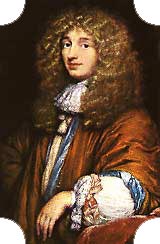 Yet the creativity of the human mind and the development of our technology is now providing preliminary evidence about the chemical composition such planets.
Yet the creativity of the human mind and the development of our technology is now providing preliminary evidence about the chemical composition such planets.
During the 4th century BC, two Greek philosophers, Aristotle and Epicurus, expressed opposing ideas about the possible existence of worlds besides Earth. Epicurus asserted that the universe must be infinite and hence contain an infinity of worlds. Aristotle argued that Earth was placed at the center of the universe, making it unique in the universe. But most of the educated peoples in the world adopted the geocentric world of Eudoxos and Ptolemy. Not until Nicolaus Copernicus suggested that we may live in a solar system did the possibility of other planets, possibly inhabited, become plausible. Planets beyond the solar system became plausible when astronomer Christiaan Huygens (1629-1695, portrait at right→) first proposed that every star was a distant Sun. Such distant planets do not emit the huge amounts of light as do stars, but rather reflect roughly a billionth as much light as their neighbor star emits. And from the earth's perspective, such planets are nearly at the same position in the sky as their much brighter star. So detecting the much smaller, nearly dark planets orbiting stars require indirect means of detection.
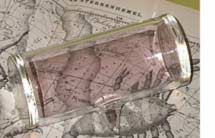 But the first evidence for the existence of such planets orbiting Sun-like stars was discovered in October 1995. A planet orbiting a star causes a small wobble in the star which is detectable as a Doppler shift in the spectra of the star.
But the first evidence for the existence of such planets orbiting Sun-like stars was discovered in October 1995. A planet orbiting a star causes a small wobble in the star which is detectable as a Doppler shift in the spectra of the star. 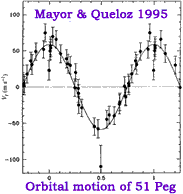 Marcy and Butler developed the world's most precise Doppler technique, capable of measuring velocity changes as tiny as 3 m/sec. (slow bicycling!). Doppler precision is achieved by inserting Iodine vapor in an absorption cell (←shown at left) near the telescope focal point. By comparing the Iodine absorption lines with those of the wobbling star, Doppler shifts in the star's wavelengths as small as 1 part in 100 million can be distinguished. Swiss astronomers Michel Mayor and Didier Queloz of the Geneva Observatory in Switzerland reported finding the first planet with this technique. (See graph at right→) They detected the Doppler shift of the star 51 Pegasi in the constellation Pegasus with a period of 4.2 days. This meant that planet is orbiting at a mere 0.05 astronomical unit (AU) from 51 Pegasi at a speed of about 134 km/sec (83 mi/sec) or 482,000 km/h (299,000 mph), more than four times faster than Earth's velocity around the Sun. In the decade after the first extrasolar planet was discovered, nearly 200 were found.
Marcy and Butler developed the world's most precise Doppler technique, capable of measuring velocity changes as tiny as 3 m/sec. (slow bicycling!). Doppler precision is achieved by inserting Iodine vapor in an absorption cell (←shown at left) near the telescope focal point. By comparing the Iodine absorption lines with those of the wobbling star, Doppler shifts in the star's wavelengths as small as 1 part in 100 million can be distinguished. Swiss astronomers Michel Mayor and Didier Queloz of the Geneva Observatory in Switzerland reported finding the first planet with this technique. (See graph at right→) They detected the Doppler shift of the star 51 Pegasi in the constellation Pegasus with a period of 4.2 days. This meant that planet is orbiting at a mere 0.05 astronomical unit (AU) from 51 Pegasi at a speed of about 134 km/sec (83 mi/sec) or 482,000 km/h (299,000 mph), more than four times faster than Earth's velocity around the Sun. In the decade after the first extrasolar planet was discovered, nearly 200 were found.
 A planet which transits across in front a star, blocking some of the starlight reaching us has been used to detect planets relatively close to a star. This was first achieved in 1999 using a relatively small 4 inch amateur telescope. It has the added benefit of providing enough information to allow for an estimate of the planet's density.
A planet which transits across in front a star, blocking some of the starlight reaching us has been used to detect planets relatively close to a star. This was first achieved in 1999 using a relatively small 4 inch amateur telescope. It has the added benefit of providing enough information to allow for an estimate of the planet's density.Infrared spectra obtained by the Spitzer Space Telescope launched by NASA has been used to gather the first data on the spectra of extrasolar planets. A team at the Harvard-Smithsonian Center for Astrophysics in Cambridge, Massachusetts, subtracted the spectra of stars when their planets were behind the star from when the planets were in front of the stars. The difference is presumably due to the spectra of the atmospheres of the planets.
Independent analysis was done by Jeremy Richardson at the Goddard Space Flight Center and by Mark Swain's team at the Jet Propulsion Laboratory of hot HD209458b, with mass similar to Jupiter, 153 light-years from Earth. Its spectrum showed a low concentration of Sodium and no water vapor. A similar planet analyzed David Charbonneau at the Harvard-Smithsonian Center, hot, Jupiter-sized HD189733b, 62 light years from Earth, also revealed no water.
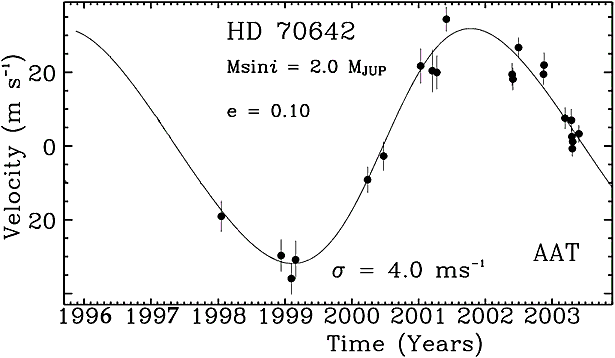
If you need course credit, use your observations recorded in your journal to construct a formal report.
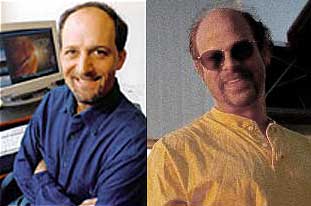 Geoff Marcy (near right→) & R. Paul Butler (far right→) Hunting Planets Beyond, Astronomy, March 2000
Geoff Marcy (near right→) & R. Paul Butler (far right→) Hunting Planets Beyond, Astronomy, March 2000![]()
to Planetary Chemistry menu
to e-Chemistry menu
to site menu